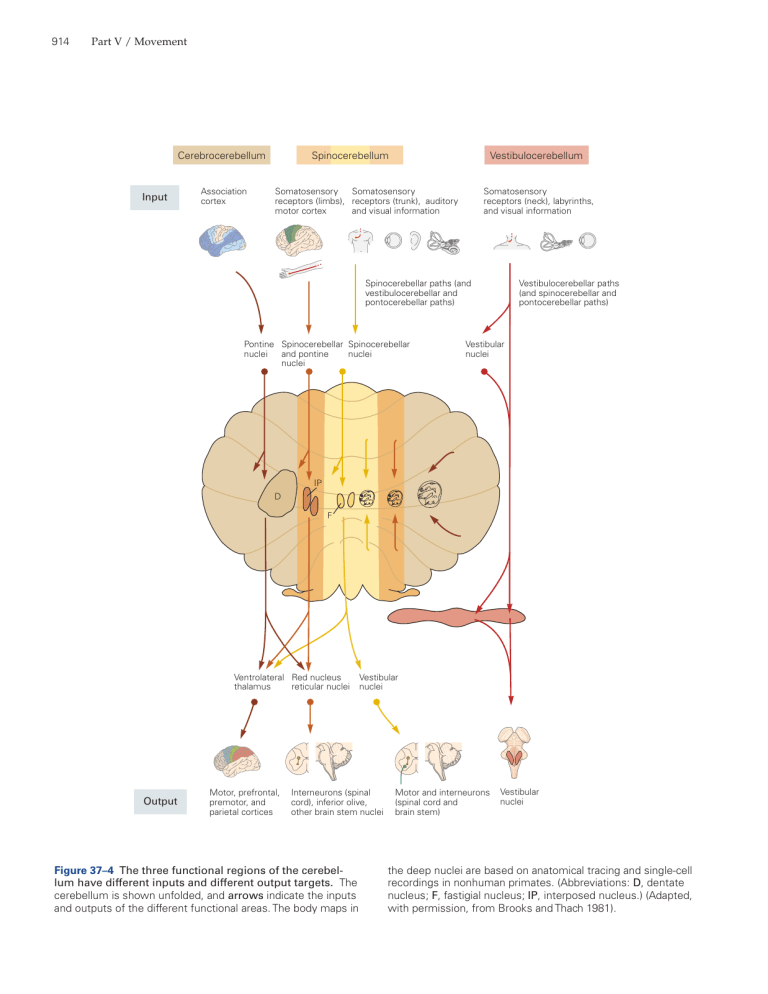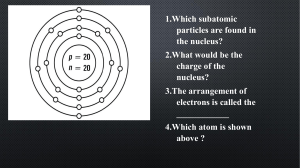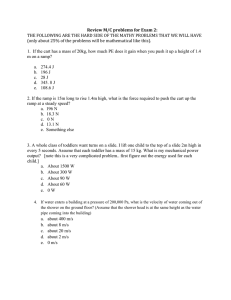
914 Part V / Movement Cerebrocerebellum Input Association cortex Spinocerebellum Vestibulocerebellum Somatosensory receptors (neck), labyrinths, and visual information Somatosensory Somatosensory receptors (limbs), receptors (trunk), auditory and visual information motor cortex Vestibulocerebellar paths (and spinocerebellar and pontocerebellar paths) Spinocerebellar paths (and vestibulocerebellar and pontocerebellar paths) Pontine Spinocerebellar Spinocerebellar nuclei nuclei and pontine nuclei Vestibular nuclei IP D F Ventrolateral Red nucleus thalamus reticular nuclei Output Motor, prefrontal, premotor, and parietal cortices Vestibular nuclei Interneurons (spinal cord), inferior olive, other brain stem nuclei Figure 37–4 The three functional regions of the cerebellum have different inputs and different output targets. The cerebellum is shown unfolded, and arrows indicate the inputs and outputs of the different functional areas. The body maps in Motor and interneurons (spinal cord and brain stem) Vestibular nuclei the deep nuclei are based on anatomical tracing and single-cell recordings in nonhuman primates. (Abbreviations: D, dentate nucleus; F, fastigial nucleus; IP, interposed nucleus.) (Adapted, with permission, from Brooks and Thach 1981). Chapter 37 / The Cerebellum A Primary and premotor cortex B 915 Primary and premotor cortex + + + + Thalamus (ventrolateral nucleus) + + Dentate nucleus Thalamus (ventrolateral nucleus) + Red nucleus Vermis Fastigial nucleus Flocculonodular lobe – – + Cerebrocerebellum + – – Medullary reticular formation Lateral vestibular nucleus Spinocerebellum Pyramidal decussation Rubrospinal tract Corticospinal tract + + Limb extensors (antigravity muscles) Interposed nuclei – To limb muscle Axial and proximal (antigravity muscles) Figure 37–5 Input and output pathways of the cerebellum. oculomotor connections of the vestibular nuclei have been omitted for clarity. A. Nuclei in the vestibulocerebellum and the vermis control proximal muscles and limb extensors. The vestibulocerebellum (flocculonodular lobe) receives input from the vestibular labyrinth and projects directly to the vestibular nuclei. The vermis receives input from the neck and trunk, the vestibular labyrinth, and retinal and extraocular muscles. Its output is focused on the ventromedial descending systems of the brain stem, mainly the reticulospinal and vestibulospinal tracts and the corticospinal fibers acting on medial motor neurons. The B. Nuclei in the intermediate and lateral parts of the cerebellar hemispheres control limb and axial muscles. The intermediate part of each hemisphere (spinocerebellum) receives sensory information from the limbs and controls the dorsolateral descending systems (rubrospinal and corticospinal tracts) acting on the ipsilateral limbs. The lateral area of each hemisphere (cerebrocerebellum) receives cortical input via the pontine nuclei and influences the motor and premotor cortices via the ventrolateral nucleus of the thalamus, and directly influences the red nucleus.




